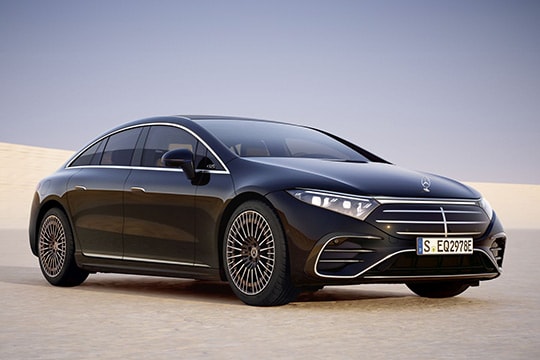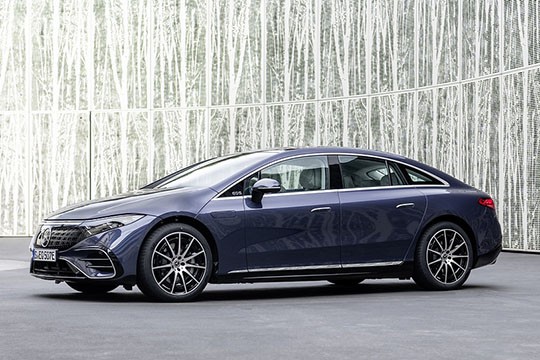MERCEDES BENZ EQS Models/Series Timeline, Specifications & Photos
First production year: 2021
Engines: Electric
In 2021, Mercedes-Benz introduced the EQS, which tried to be the all-electric alternative to the brand’s flagship model, the S-Class, and refreshed it just three years later, in April 2024.
The German automaker has always been at the forefront of technology and tried to stay ahead of its competition when it launched the EQS. Even though it was luxurious and provided advanced features, its customers didn’t perceive it as an authentic electric version of the S-Class. But Mercedes-Benz didn’t drop the towel, and its engineers burnt the midnight oil to improve it. As a result, in the spring of 2024, it released the facelifted version of the EQS, almost three years after the model’s production started in April 2021. The new version came with a larger battery that allowed it to travel more and also featured emblematic details on the exterior that resembled other former glories from the carmaker’s lineup.
At the front, the automaker installed its traditional three-pointed star badge upright on the hood, resembling past models from the Mercedes-Benz lineup. Below, on the panel that replaced the traditional grille, the EQS sported a new design with three horizontal lines, echoing the pattern used on the S-Class. Lower, on the apron, the car manufacturer installed an A-shaped lower air intake flanked by a pair of scoops featuring three horizontal slats.
When Mercedes-Benz unveiled the EQS, it bragged about the car’s incredibly low drag resistance coefficient of just 0.20. The refreshed version kept that value. To improve the car’s look, the automaker offered the EQS with wheels ranging between 19 and 21 inches, depending on the options. At the back, the taillights featured spiral-like LED elements continued on the trunk lid by a single line.
Mercedes-Benz tried to improve the EQS cabin in more ways than customers could dream of. Besides the frameless windows for the doors, which were present on the non-facelifted version, the 2024 model year came with significant upgrades. The heat pump, which was unavailable in the 2021 version, was fitted standard across the range. As a result, the car could travel more on a single charge during wintertime. The hyperscreen monitor was still available, and customers loved that look. In the back, the automaker offered the EQS with either a bench seat or two individual comfortable seats and a narrower, third one between them, in the Manufaktur personalization program. The Rear Comfort Package Plus offered passengers the option to tilt the seatbacks of their seats from 27 up to 38 degrees at the touch of a button.
The 2024 EQS could be fitted with a 118 kWh battery instead of the 108.4 kWh one previously used. Thanks to it, the EQS 450 4Matic could travel up to 799 km (496.5 miles) on a single charge, which was 82 km (51 miles) more than its predecessor. Moreover, the 450+ version could go even beyond that. Besides the new, larger battery, the automaker also improved the energy recuperation system, so drivers could use it as a one-pedal driving vehicle. Furthermore, the car could be driven in a Level 2 autonomous system in Europe and could automatically change lanes on the highway. Mercedes-Benz also installed standard rear-axle EQS steering with a 4.5-degree angle, with an option for a 10-degree maximum counter-steering angle.
The electric-car frenzy caught the big German carmaker and introduced an electric luxury vehicle on the market in 2021: the EQS.
With more and more carmakers joining the electric revolution, Mercedes-Benz couldn’t just sit and wait to see what will go next, and it developed a completely new car in its lineup: the EQS. It started with a blank sheet of paper and moved forward until it made one of the most luxurious electric cars on the market.
With a drag resistance of just 0.20, it was the most aerodynamic production car in the world to that date. Despite its size and height, it could cut through the air seamlessly. At the front, the car featured a closed upper grille and a lower grille with shutters needed to cool the batteries and the electrical system. A pair of side-scoops adorned with horizontal slats completed the elegant yet aggressive look of the front fascia. The extended greenhouse connected the A-pillars to the D-pillars with an arch towards the rear taillights. Strangely though, the EQS featured physical rear-view mirrors while other carmakers already replaced them with rear-view cameras.
Inside, the main attraction was the dashboard fitted with three large screens: one in front of the driver, one in front of the front passenger, and the third one filling the center stack. In addition, the driver has a new steering wheel with buttons incorporated on the rim instead of the spokes. Thanks to the big wheelbase, the rear passengers could enjoy plenty of legroom and enough headroom due to the extended roof.
The powertrain offered a rear motor (eATS) for the base model or dual motors for the 4Matic version.

